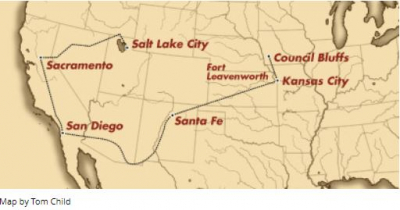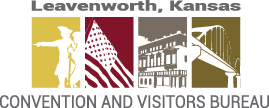The Mormon Battalion at Fort Leavenworth
Fort Leavenworth became a major influence in the Mexican-American War by serving as an induction center and base from which soldiers deployed.
In need of troops, President James K. Polk ordered the recruitment of a battalion of Mormon men in June 1846. Once the order was received by Brig. Gen. Stephen W. Kearney at Fort Leavenworth, he sent Capt. James Allen, a regular Army officer serving in the 1st Dragoons, to Iowa Territory to complete the task. Allen, in cooperation with Brigham Young, raised a battalion of more than 500 men in Kanesville, present-day Council Bluffs.
Departing Kanesville on July 20, they marched the 180 miles along the east bank of the Missouri River, arriving at Fort Leavenworth on Aug. 1, 1846, spending most of the day crossing the river on the military ferry. During its two-week stay, the battalion was bivouacked near Thomas and Pope Avenues. The battalion was outfitted with firearms and accouterments, and the means to carry and maintain them, but was not issued uniforms. They were issued a clothing allowance, which many used to purchase clothing items and goods needed along the trail.
For the most part, the soldiers went to war in civilian clothing. They were issued knapsacks, haversacks, and canteens. Tents, cooking gear, and supplies were hauled in wagons.
Upon leaving the post in mid-August, 1846 the battalion headed southwest along the Santa Fe Trail. After arriving in San Diego the battalion completed a 2,000-mile march, one of the longest marched in U.S. Army history.
Some of the battalion's accomplishments were helping to open trails to the West, helping Kearney stabilize post-conflict in California, building Fort Moore in Los Angeles, and providing support to local citizens in San Diego, or what we today call Civil Affairs Missions.



